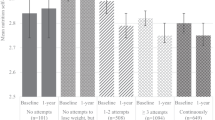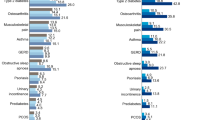Abstract
Background:
Public policies and clinical guidelines encourage people to achieve and maintain a healthy weight and societal culture, especially among women who tend to idealise thinness.
Objectives:
To examine trends over time in the prevalence of weight loss attempts in England (1997–2013) and to investigate if the characteristics associated with attempts to lose weight have changed.
Methods:
Observational study using nationally representative data on adults ⩾18 years who participated in the Health Survey for England (HSE) in 1997 (n=8066), 1998 (n=14 733), 2002 (n=8803), 2012 (n=7132) and 2013 (n=7591), with self-reported attempts to lose weight, cardiovascular disease (CVD) events or medications and measured height, weight and blood pressure. Multivariable logistic regression was used to assess the association between weight loss attempts and survey year, socio-demographic variables and health status.
Results:
The age-standardised prevalence of weight loss attempts in the English population increased from 39% in 1997 to 47% in 2013. In 2013, 10% of those with BMI <22; 30% with BMI ⩾22 to <25; 53% with BMI ⩾25 to <30; and 76% with BMI ⩾30 were trying to lose weight. The odds of trying to lose weight increased linearly with each year: odds ratio (OR) 1.021 (95% confidence interval (CI) 1.018–1.024) and 1.024 (95% CI 1.008–1.039) after adjustment for changes in BMI and population characteristics. The biggest predictors of weight loss attempts were being in the overweight/obese categories: 5.42 (95% CI 5.05–5.81) and 12.68 (95% CI 11.52–13.96), respectively; and among women: 3.01 (95% CI 2.85–3.18). Having a BMI >25 and a CVD-related condition was associated with only a small increase in the odds of trying to lose weight. There was no evidence that these predictors changed over time.
Conclusions:
More people are making weight loss attempts each year across all BMI categories. Having a health condition that would improve with weight loss was only very modestly associated with an increase in reported weight loss attempts, which reinforces data that suggests people’s prime motivation to lose weight is unrelated to health.
This is a preview of subscription content, access via your institution
Access options
Subscribe to this journal
Receive 12 print issues and online access
$259.00 per year
only $21.58 per issue
Buy this article
- Purchase on Springer Link
- Instant access to full article PDF
Prices may be subject to local taxes which are calculated during checkout




Similar content being viewed by others
References
Health and Social Care Information Centre Statistics on Obesity, Physical Activity and Diet 2015.
Health and Social Care Information Centre Statistics on Obesity, Physical Activity and Diet 2009.
National Institute of Health and Clinical Excellence (NICE) Prevention of Cardiovascular Disease 2010.
England N . Five Year Forward View. HM Government: London, 2014.
Health Do Change4Life Marketing Strategy. Crown copyright: London, 2009.
Trindade IA, Ferreira C . Falling in the traps of your thoughts: the impact of body image-related cognitive fusion on inflexible eating. Eat Behav 2015; 19: 49–52.
Joint Health Surveys Unit of Social and Community Planning Research and University College London Health Survey for England, 3rd edn. UK Data Archive: Colchester, Essex: UK, 1997.
Craig R, Mindell J . Health Survey for England 2013. Volume 2: Methods and Documentation. Health and Social Care Information Centre: Leeds, 2014.
Centre for Public Health Excellence at NICE; National Collaborating Centre for Primary Care Obesity: The Prevention, Identification, Assessment and Management of Overweight and Obesity in Adults and Children. National Institute of Health and Clinical Excellence (NICE): London, 2006.
Organization WH. Obesity: preventing and managing the global epidemic, World Health Organization, 2000.
Wardle J, Griffith J, Johnson F, Rapoport L . Intentional weight control and food choice habits in a national representative sample of adults in the UK. Int J Obesity 2000; 24: 534–540.
Button E, Sonuga‐Barke E, Davies J, Thompson M . A prospective study of self‐esteem in the prediction of eating problems in adolescent schoolgirls: questionnaire findings. Br J Clin Psychol 1996; 35: 193–203.
Wardle J, Marsland L . Adolescent concerns about weight and eating; a social-developmental perspective. J Psychosom Res 1990; 34: 377–391.
Roberts SJ, McGuiness PJ, Bilton RF, Maxwell SM . Dieting behavior among 11–15-year-old girls in Merseyside and the Northwest of England. J Adolesc Health 1999; 25: 62–67.
Jackson SE, Wardle J, Johnson F, Finer N, Beeken RJ . The impact of a health professional recommendation on weight loss attempts in overweight and obese British adults: a cross-sectional analysis. BMJ Open 2013; 3: e003693.
Serdula MK, Mokdad AH, Williamson DF, Galuska DA, Mendlein JM, Heath GW . Prevalence of attempting weight loss and strategies for controlling weight. JAMA 1999; 282: 1353–1358.
Phelan S, Wing RR, Loria CM, Kim Y, Lewis CE . Prevalence and predictors of weight-loss maintenance in a biracial cohort: results from the coronary artery risk development in young adults study. Am J Prev Med 2010; 39: 546–554.
Weiss EC, Galuska DA, Khan LK, Serdula MK . Weight-control practices among US adults, 2001–2002. Am J Prev Med 2006; 31: 18–24.
Kakinami L, Gauvin L, Barnett TA, Paradis G . Trying to lose weight: the association of income and age to weight-loss strategies in the US. Am J Prev Med 2014; 46: 585–592.
Blokstra A, Burns C, Seidell J . Perception of weight status and dieting behaviour in Dutch men and women. Int J Obes 1999; 23: 7–17.
Williamson DF, Serdula MK, Anda RF, Levy A, Byers T . Weight loss attempts in adults: goals, duration, and rate of weight loss. Am J Public Health 1992; 82: 1251–1257.
Kruger J, Galuska DA, Serdula MK, Jones DA . Attempting to lose weight: specific practices among US adults. Am J Prev Med 2004; 26: 402–406.
Yaemsiri S, Slining MM, Agarwal SK . Perceived weight status, overweight diagnosis, and weight control among US adults: the NHANES 2003-2008 Study. Int J Obes (Lond) 2011; 35: 1063–1070.
Bish CL, Blanck HM, Serdula MK, Marcus M, Kohl HW, Khan LK . Diet and physical activity behaviors among Americans trying to lose weight: 2000 Behavioral Risk Factor Surveillance System. Obes Res 2005; 13: 596–607.
Ferreira C, Trindade IA, Martinho A . Explaining rigid dieting in normal-weight women: the key role of body image inflexibility. Eat Weight Disord 2015; 21: 49–56.
Kenardy J, Brown WJ, Vogt E . Dieting and health in young Australian women. Eur Eat Disord Rev 2001; 9: 242–254.
Neumark‐Sztainer D, Shenvood NE, French SA, Jefsery RW . Weight control behaviors among adult men and women: cause for concern? Obes Res 1999; 7: 179–188.
Markey CN, Markey PM . Relations between body image and dieting behaviors: an examination of gender differences. Sex Roles 2005; 53: 519–530.
Crossley KL, Cornelissen PL, Tovee MJ . What is an attractive body? Using an interactive 3D program to create the ideal body for you and your partner. PLoS One 2012; 7: e50601.
Lavie CJ, Milani RV, Artham SM, Patel DA, Ventura HO . The obesity paradox, weight loss, and coronary disease. Am J Med 2009; 122: 1106–1114.
Wing RR, Lang W, Wadden TA, Safford M, Knowler WC, Bertoni AG et al. Benefits of modest weight loss in improving cardiovascular risk factors in overweight and obese individuals with type 2 diabetes. Diabetes Care 2011; 34: 1481–1486.
Hartmann‐Boyce J, Johns D, Jebb S, Aveyard P . Effect of behavioural techniques and delivery mode on effectiveness of weight management: systematic review, meta‐analysis and meta‐regression. Obes Rev 2014; 15: 598–609.
Hartmann‐Boyce J, Johns D, Jebb S, Summerbell C, Aveyard P . Behavioural weight management programmes for adults assessed by trials conducted in everyday contexts: systematic review and meta‐analysis. Obes Rev 2014; 15: 920–932.
Hartmann-Boyce J, Jebb SA, Fletcher BR, Aveyard P . Self-help for weight loss in overweight and obese adults: systematic review and meta-analysis. Am J Public Health 2015; 105: e43–e57.
Acknowledgements
Data from the Health Survey for England were used with permission of the UK Data Archive, University of Essex, Wivenhoe Park, Colchester, Essex, CO4 3SQ. This analysis was funded by the University of Oxford. The Health Survey for England was funded by the Department of Health.
Author contributions
CP, PA and SAJ designed research; CP, PA and SAJ conducted research; CP, PA and SAJ performed statistical analysis; CP, PA and SAJ wrote paper; CP, PA and SAJ had primary responsibility for final content. All authors read and approved the final manuscript.
Author information
Authors and Affiliations
Corresponding author
Ethics declarations
Competing interests
The authors declare no conflict of interest.
Additional information
Supplementary Information accompanies this paper on International Journal of Obesity website
Supplementary information
Rights and permissions
About this article
Cite this article
Piernas, C., Aveyard, P. & Jebb, S. Recent trends in weight loss attempts: repeated cross-sectional analyses from the health survey for England. Int J Obes 40, 1754–1759 (2016). https://doi.org/10.1038/ijo.2016.141
Received:
Revised:
Accepted:
Published:
Issue Date:
DOI: https://doi.org/10.1038/ijo.2016.141
This article is cited by
-
‘Willpower’ is not enough: time for a new approach to public health policy to prevent obesity
BMC Medicine (2023)
-
Extended follow-up of a short total diet replacement programme: results of the Doctor Referral of Overweight People to Low Energy total diet replacement Treatment (DROPLET) randomised controlled trial at 3 years
International Journal of Obesity (2021)
-
Support needs of patients with obesity in primary care: a practice-list survey
BMC Family Practice (2018)



